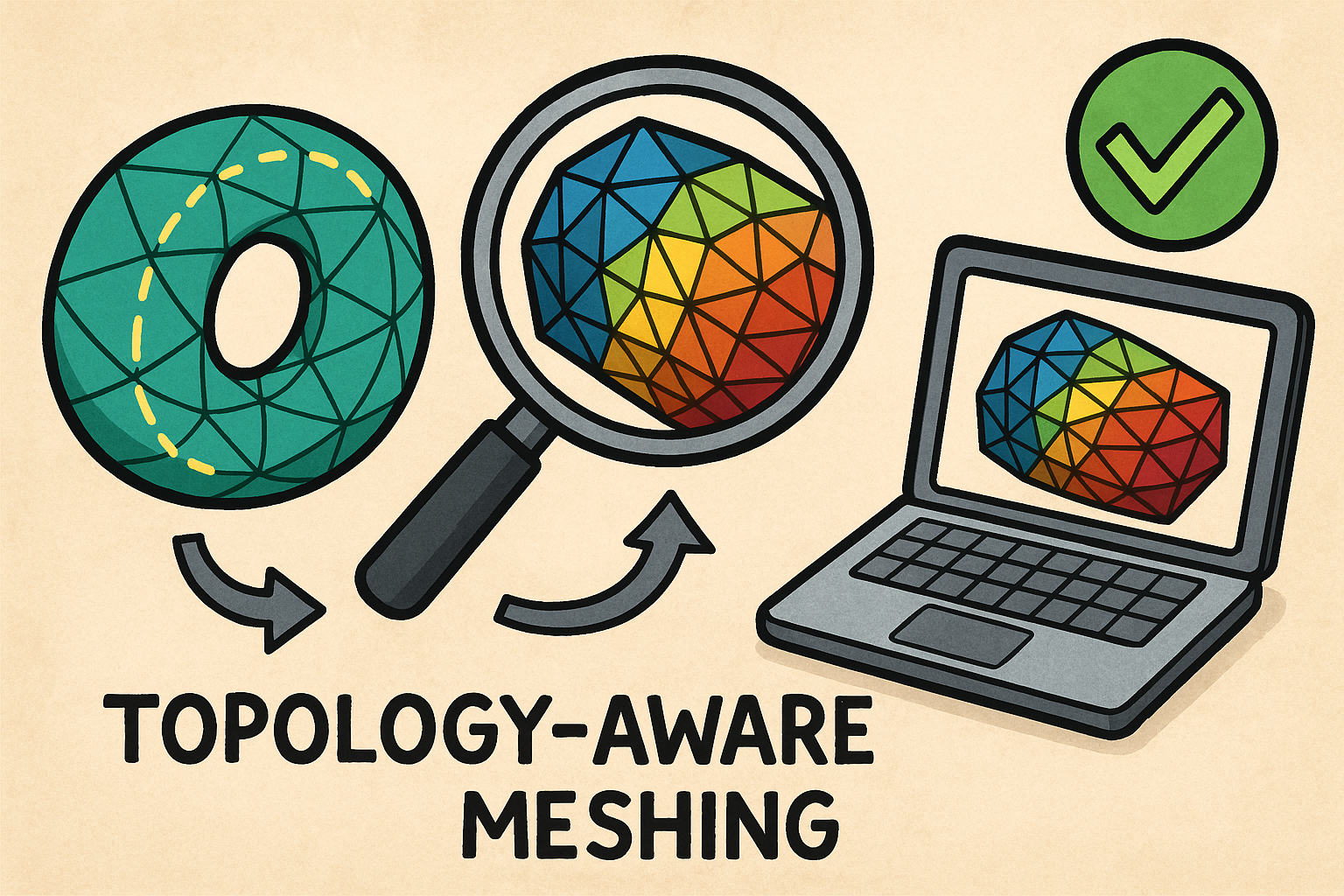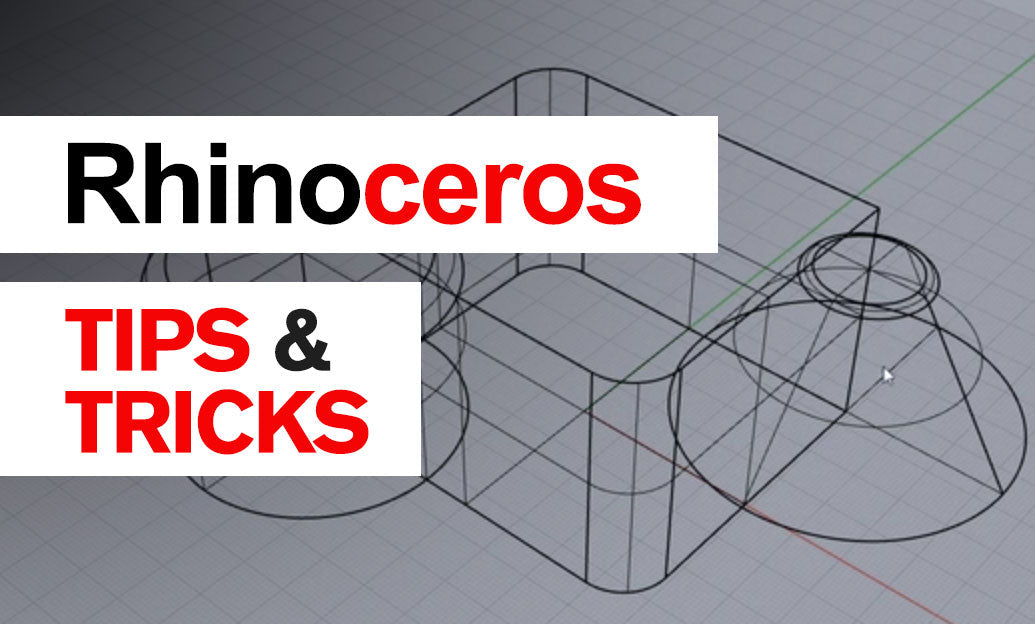Your Cart is Empty
Customer Testimonials
-
"Great customer service. The folks at Novedge were super helpful in navigating a somewhat complicated order including software upgrades and serial numbers in various stages of inactivity. They were friendly and helpful throughout the process.."
Ruben Ruckmark
"Quick & very helpful. We have been using Novedge for years and are very happy with their quick service when we need to make a purchase and excellent support resolving any issues."
Will Woodson
"Scott is the best. He reminds me about subscriptions dates, guides me in the correct direction for updates. He always responds promptly to me. He is literally the reason I continue to work with Novedge and will do so in the future."
Edward Mchugh
"Calvin Lok is “the man”. After my purchase of Sketchup 2021, he called me and provided step-by-step instructions to ease me through difficulties I was having with the setup of my new software."
Mike Borzage
Topology-Aware Meshing: Preserving Homology, Quality, and Solver Reliability
November 19, 2025 12 min read


Why topology-aware meshing matters: failure modes and success criteria
The problem
Complex CAD and B-Rep models encode far more than smooth surfaces; they encode the very connectivity that governs how physics flows through a domain. When those models carry non-manifold edges, micro-gaps at tolerances, near-zero-thickness features, high-genus tunnels, or multi-material junctions, a naïve mesher can quietly rewrite the topology. The result is a numerical model whose equations are solved perfectly on the wrong shape. The danger is subtle: a mesh that visually “looks right” can still have lost handles, closed off cavities, or merged thin walls. Each of these incidents alters constraints in governing PDEs, introduces artificial stiffness, or blocks transport paths that the design intended to keep open. The first step is acknowledging that geometry and topology must be co-managed, and that a mesh is a topological artifact as much as a geometric one. To make this concrete, watch for the common traps that hide under otherwise impressive surface renderings. - Non-manifold edges and T-junctions masquerading as valid watertight seams. - Micro-gaps and overlaps created by mixed tolerances from supplier parts. - Thin features whose thickness falls below a few element sizes, inviting wall merging. - High-genus parts where tunnels get sealed by over-aggressive gap filling. - Multi-material junctions that should be intentionally non-manifold but are “fixed” away. A topology-aware pipeline keeps these patterns explicit. It treats **topology preservation** as a requirement, not a side-effect, and forces any operation that might eliminate a cavity or connect two components to make that action visible, reversible, and measured against homology invariants.Solver impacts
The mesh is the discrete lens through which the solver “sees” the physics. Once topology has drifted or poor elements sneak in, downstream solvers pay a heavy price in stability, accuracy, and conditioning. Instability often comes first: sliver tetrahedra, needle prisms, or inverted curved elements corrupt residual evaluation and cause nonlinear iterations to stall or blow up. Even when the solver limps to a solution, the answer can be biased; closing a tunnel redirects flow or current, merging thin walls stiffens the structure, and coarse linearization of curved boundaries injects **geometric dispersion** into wave or eigenmode problems. The final insult is numerical conditioning: extreme aspect ratios or abrupt gradation spikes inflate the matrix condition number, driving up preconditioner cost and memory footprint. These impacts are not theoretical; they appear as extra Newton steps, fragile time-step ceilings, and low-fidelity modal counts that mislead design decisions. - Instability: slivers, negative Jacobians in high-order elements, and poorly curved boundaries. - Accuracy loss: biased flow and stiffness paths; under-resolved curvature and boundary layers. - Conditioning penalties: huge aspect ratios and abrupt size jumps that poison preconditioners. - Increased cost: more linear iterations, tighter time steps, and brittle convergence. By elevating **mesh quality** and **topology invariance** to explicit success criteria, we prevent the solver from becoming a debugging tool for geometry. Instead, the mesh becomes a stable, predictable conduit for the physics that the design intends to express.Success criteria to define up front
Successful meshing is not a happy accident; it is the result of clear criteria enforced early and audited repeatedly. Start by making topology measurable. Compute Betti numbers b0, b1, and b2 on the CAD-derived cell complex and demand they match on the mesh. This prohibits spurious connections and lost cavities. Next, bind geometric fidelity with a bounded **Hausdorff error**, and use curvature-aware sizing so principal curvatures drive local element size. For high-order meshes, require **positive Jacobians** under CAD-evaluated curving to keep elements physically valid. Layer in physics-aware metrics: CFD boundary layers need target y+; thin solids need through-thickness elements; vibro-acoustics needs wavelength resolution at a chosen points-per-wavelength. Finally, govern classical quality limits such as skewness, dihedral angles, and gradation ratios, and enforce sliver suppression thresholds so no element can sneak in below acceptable shape metrics. - Topology preservation: match Betti numbers; no unintended connectivity. - Geometric fidelity: bounded surface deviation; curvature-driven metrics. - Physics-aware metrics: y+, thickness coverage, and wavelength-based sizing. - Positivity: high-order Jacobians strictly positive with curving safeguards. - Quality envelope: skewness/angle bounds, gradation < 1.3–1.5, sliver suppression. With these constraints established at the outset, meshing becomes a controlled optimization. The team can trade element count against fidelity with confidence that the most damaging failures—topology flips and invalid curved elements—are prevented by design.Algorithms and representations that “see” topology
Topology extraction and diagnostics
A topology-aware workflow begins by translating B-Rep data into a cell complex on which homology can be computed. Instead of trusting layer-cake STEP or IGES faces blindly, convert to a structure where edges, faces, and volumes carry incidence relations without ambiguity. Once in that form, evaluate connected components and compute homology groups; **persistent homology** is particularly robust because it tolerates small gaps by sweeping a tolerance scale and observing when features persist. Complement homology with a medial axis or skeletal analysis to estimate the local feature size (LFS), which flags thin regions and necks where refinement or coarsening can cause a topology flip. Finally, attribute the topology graph: mark intended interfaces including contact pairs, periodic and symmetry boundaries, material IDs, porous subregions, and deliberate non-manifold junctions such as multi-material T-edges. This enriched representation lets downstream algorithms reason about both geometry and the meaning of connections. - Convert B-Rep to a cell complex with clean incidence relations. - Compute b0, b1, b2; use persistent homology to resist tolerance noise. - Extract medial axis and LFS to locate thin sections and critical necks. - Build a topology graph with interface types, materials, and porous tags. - Flag intentional non-manifolds so “fixers” do not erase them. Once extracted, this diagnostic layer acts as a contract. Every meshing operation is permitted only if it preserves marked invariants or records a deliberate, approved change in the topology ledger.Surface preparation with guarantees
Surface healing is often where topology goes to die. To avoid that fate, use tolerant sewing and gap filling that reports and bounds error against the original CAD. Water-tightness and manifoldization should be performed with **edge multiplicity** checks: edges intended to be shared by more than two faces must remain non-manifold if the topology graph says so. When suppressing features, shift from ad-hoc rules to topology-safe policies: remove fillets or holes only when a stated policy is met and homology is provably invariant or the feature is flagged as dispensable by design intent. For curvature control, generate reliable normals and principal curvature fields and store them as attributes to drive metric synthesis later. When high-order meshing or isogeometric projections are planned, include precise projectors to the CAD kernel so that later **curving** operations can evaluate exact geometry and enforce positivity. - Watertight: tolerant sew with explicit error bounds and audit trail. - Manifoldization with intent: preserve specified non-manifold junctions. - Topology-safe simplification: only when homology stays invariant. - Curvature tagging: normals and curvature fields for size control. - CAD projectors: prepare for accurate and safe high-order curving. These guarantees transform surface prep into a contract-respecting stage, ensuring that what leaves the surface pipeline is admissible for volume meshing without silent topological edits.Volume meshing strategies
Volume meshing choices carry different strengths. Tetrahedral meshing remains a general-purpose workhorse. Use **Constrained Delaunay** with anisotropic metric fields derived from curvature and physics pre-estimates such as Reynolds number or wavelength. Apply sliver exudation and local flips to prevent low-quality tets. For alignment and layers, hex and hex-dominant strategies are powerful. Frame-field and **integer-grid-map** methods reveal global alignment, while plastering or grafting strategies near boundaries maintain quality. Proper pyramid and prism transitions with safeguards prevent stair-stepping and preserve orientation across sharp corners. Polyhedral meshing boosts robustness in cluttered assemblies, and cut-cell or immersed approaches shine when small gaps make body-fitted meshing impractical; mortar or Nitsche coupling can stitch interfaces while preserving consistent topology labels. Boundary-layer extrusion should be topology-aware, stopping layers across junctions where overlap would cause tangling, and using curvature-aware marching to avoid self-intersections. - Tet: Constrained Delaunay, anisotropic metrics, sliver cleanup, local flips. - Hex-dominant: frame fields, integer grid maps, controlled prism/pyramid transitions. - Boundary layers: y+ targets, junction-aware stop conditions, corner protection. - Poly/cut-cell: robust coarsening, small-gap tolerance, mortar/Nitsche coupling. - Audit: ensure cavities, tunnels, and interfaces match the topology graph. Choosing the right strategy per region, and allowing hybrids, often yields the best compromise between alignment, robustness, and solver conditioning.High-order and interface handling
High-order meshes can deliver dramatic accuracy per DOF, but only if curving is done against CAD with strict Jacobian positivity. The safe path is incremental p-elevation: curve edges, then faces, then interiors, validating Jacobians after each step. When distortions threaten positivity, use local optimization with barrier energies to untangle while honoring boundary constraints. At materials and multi-physics boundaries, **multi-domain conformity** is ideal, but in real assemblies non-conformal interfaces are sometimes unavoidable. When that happens, deploy dual or mortar constraints and ensure consistent topology labels so interface conditions are correctly enforced. Adaptivity is another risk point for topology: r-adapt and h-adapt should be guided by error estimators but caged by homology constraints and minimum-thickness-aware metrics to prevent collapse of thin walls or accidental closure of pores. The result is a dynamic mesh that learns from the solution without rewriting the design. - High-order curving: CAD-evaluated, incremental, Jacobian positivity checks. - Interface options: conformal preferred; non-conformal with mortar/dual if required. - Adaptivity: error-driven but topology-locked, thickness-aware safeguards. - Untangling: barrier energy optimization with CAD-constrained projections. - Label fidelity: preserve material and interface IDs across refinement/coarsening. Handled this way, high-order and adaptive strategies deliver their promised accuracy and efficiency while protecting the topology that gives the physics its shape.Practical workflow patterns in design software
End-to-end pipeline
An end-to-end pipeline that treats topology as a first-class citizen looks different from a typical “import-and-mesh” pushbutton. It begins at CAD intake with tolerance unification and robust repair that is intentional, logged, and bounded. Semantic tagging of materials, boundaries, periodicity, and interfaces builds the topology graph. A topology report early in the process states b0, b1, b2 and flags thin regions from the medial axis. Next, metric synthesis blends curvature fields, user intent (keep/remove features), and physics pre-solves—potentially from adjoint analysis or a **neural operator** that estimates error—to yield a spatial metric tensor. Meshing runs in parallel but deterministically, applying quality gates for skewness, dihedral angles, and Jacobians, and it performs a topology audit vs the original graph with automatic local fixes orchestrated by policy. Solver coupling then maps initial and boundary conditions consistently, enables on-the-fly adaptivity with topology locks, and version-controls the mesh with provenance that ties it to geometry revisions. - CAD intake: unify tolerances, heal with error bounds, tag semantics. - Topology report: compute Betti numbers, list thin regions and junctions. - Metric synthesis: curvature + intent + physics-inferred tensor fields. - Meshing: parallel, deterministic, quality gates, topology audit with fixes. - Solver coupling: IC mapping, adaptive loops, mesh versioning tied to CAD. This disciplined pipeline makes topology unmissable; it is computed, displayed, preserved, and audited from first import to final solution.Scaling to real assemblies
Large assemblies stress every assumption. To scale, partitioning must be topology-aware: place cuts where interfaces exist or where the topology graph allows, and use ghost layers to maintain consistent interface quality across partitions. Out-of-core surface healing and streaming meshing keep memory bounded, while ensuring that topology diagnostics run on chunks but reconcile globally at merge time. Attribute propagation is critical; PMI/MBD data, material assignments, and interface semantics should survive decimation, refinement, and export to co-simulation frameworks. For complex assemblies with many small gaps, polyhedral or cut-cell approaches can avoid weeks of manual cleanup while keeping **consistent topology labels** across parts. The orchestration layer should capture inter-part constraints, periodic pairs, and contact candidates so downstream solvers do not have to guess. Finally, ensure determinism across machines by fixing seeds and using robust predicates; nothing breaks trust like a mesh that changes across runs on the same dataset. - Topology-aware partitioning and ghost layers for interface fidelity. - Out-of-core healing and streaming meshing for massive models. - Attribute propagation: PMI/MBD, materials, interfaces through all ops. - Poly/cut-cell strategies for gap-heavy assemblies with stable labels. - Deterministic meshing across nodes and OS versions. When designed this way, the assembly workflow resists combinatorial explosion and maintains both quality and intent as the model scales.Robustness and determinism
Robust geometry predicates and deterministic algorithms form the backbone of a trustworthy meshing system. Interval arithmetic, exact predicates, and filtered kernels prevent tolerance-induced flips that otherwise cause non-manifoldness or inversion during curving. Reproducibility is enforced by fixed seeds, stable sorting of events, and parallel algorithms designed to be deterministic. Quality governance extends beyond a single project; a continuous integration suite should include an evolving zoo of “nasty” geometries such as lattices, vascular networks, turbomachinery, and thin-foil shells. Each new build runs automatic regression on homology invariants, Hausdorff distances, angle distributions, and condition estimates derived from proxy matrices. Failures should be actionable: identify exactly which edge multiplicity or face self-intersection violated constraints, and gate the release until resolved. This discipline shifts robustness from heroics to process, improving reliability at scale and freeing engineers to focus on design rather than data hygiene. - Exact and filtered predicates to avoid tolerance-driven errors. - Deterministic parallelism: fixed seeds, stable event ordering. - CI governance: homology, geometry error, quality, conditioning regressions. - Release gates: fail on unintended topology changes or Jacobian negativity. - Actionable diagnostics: pinpoint edges/faces for correction. With these guardrails, the pipeline becomes predictable, auditable, and safe for automation in enterprise environments.UX patterns that build trust
Great algorithms still need a user experience that surfaces topology and quality in ways designers can act on. A live **Topology Radar** that visualizes tunnels, voids, and thin regions makes abstract invariants tangible; when a surface operation risks changing homology, the UI should warn, quantify the delta, and offer alternatives such as switching to non-conformal coupling. Before meshing, previews for y+, minimum thickness coverage, and wavelength resolution let users tune metrics using sliders for feature suppression while watching homology stay invariant. During meshing and curving, real-time Jacobian positivity meters and corner-layer overlap alerts prevent loss of time to doomed attempts. If something fails, the explanation should be crisp: highlight the exact edge causing non-manifoldness or the face whose curvature exceeds current metric bounds, along with one-click fixes or a link to escalate to poly/cut-cell. These UX patterns convert topology-aware best practices into everyday decisions a designer can make with confidence. - Live topology and thin-region visualization with homology deltas. - Pre-mesh physics previews: y+, thickness, wavelength coverage. - Real-time quality gauges: Jacobians, skewness, layer overlap. - Guided remediation: pinpoint defects and suggest safe alternatives. - Transparent provenance: change logs linking geometry, metrics, and mesh. Such UX builds trust and shortens iteration cycles, aligning user intuition with the safeguards that keep meshes faithful to intent.Conclusion
Takeaways
The core lesson is to treat topology as a signal, not a byproduct. Preserving homology and intended interfaces measurably improves stability, conditioning, and accuracy. Geometric controls like bounded **Hausdorff error** and curvature-aware sizing keep surfaces honest, while physics-aware metrics put DOFs where they matter—boundary layers, thin walls, and wavelengths. High-order efficiency only pays when **positive Jacobians** are enforced through CAD-evaluated curving and barrier-based untangling. Adaptivity must be topology-aware, with homology locks and minimum-thickness limits preventing flips during refinement or coarsening. On the organizational side, determinism, robust predicates, and CI governance transform robustness from art to engineering. The result is a pipeline where meshing is no longer a source of mystery or solver drama, but a dependable, explainable stage that encodes the design’s physics with integrity. In this landscape, designers iterate faster, solvers converge more reliably, and decisions rest on data aligned with the true shape of the problem. - Topology preservation improves solver behavior across the board. - Geometry-, physics-, and intent-driven metrics work best together. - High-order and adaptivity succeed only when curving remains valid. - Determinism and CI sustain reliability at scale. By institutionalizing these principles, teams move from firefighting to predictable, high-fidelity simulation.Action checklist
Turn these ideas into practice with a concise checklist that spans intake to solution. Compute and track b0/b1/b2 from the CAD cell complex through the final mesh; fail fast on unintended changes. Use medial-axis-based feature size to cap coarsening in thin regions and enforce gradation limits to keep conditioning under control. Couple meshing to boundary-layer targets, through-thickness requirements, and wavelength criteria; let adjoint or learned estimators refine the metric where sensitivity is high. Enforce deterministic meshing with robust predicates and a CI suite that includes pathological geometries, measuring homology, surface error, element quality, and proxy condition numbers. Finally, instrument the UX with live topology views, physics previews, and explainable failure messages. This operationalizes the theory so that every mesh produced is explainable, reproducible, and physically trustworthy. - Track homology from CAD to mesh; abort on unintended deltas. - Cap coarsening via medial axis and impose gradation ceilings. - Tie metrics to y+, thickness, and points-per-wavelength targets. - Make meshing deterministic; guard with CI on “nasty” models. - Provide UX that visualizes topology and explains failures. With this checklist embedded, teams can scale confident, topology-aware meshing across programs and platforms.What’s next
The near future points to smarter metrics and tighter CAD coupling. **Neural metric predictors** conditioned on topology graphs can infer anisotropy and size from a blend of geometry, boundary conditions, and historical solver residuals, seeding meshes that are both lighter and safer. Certified topology-preserving adaptive loops that bake homology checks into every refine/coarsen step will bring push-button adaptivity to complex assemblies without risking flips. On the representation side, convergence between CAD kernels and isogeometric analysis will remove meshing entirely for certain classes of models while retaining topology guarantees and positivity for analysis-suitable parameterizations. Finally, scalable poly/hex-dominant pipelines with provable quality bounds are on the horizon for highly multi-material, high-genus designs, bringing together frame fields, integer-grid maps, and cut-cell hybrids under one deterministic, auditable umbrella. The destination is clear: meshes and parameterizations that encode topology and intent so faithfully that the solver’s only job is to compute, not to compensate. - Learned metrics conditioned on topology and physics context. - Certified adaptivity with embedded homology invariants. - CAD-kernel and IGA convergence with positivity and fidelity guarantees. - Scalable poly/hex-dominant pipelines with provable bounds. As these capabilities mature, topology-aware meshing will shift from best practice to baseline expectation, quietly enabling the next decade of high-confidence simulation-driven design.Also in Design News

Design Software History: From Kinematics Add‑Ons to Industrial Multibody Dynamics: Algorithms, Applications, and Design Integration
November 19, 2025 13 min read
Read More
Rhino 3D Tip: Rhino Mesh Validation for 3D Printing, Simulation, and Visualization
November 18, 2025 2 min read
Read More
Cinema 4D Tip: Depth of Field Workflow for Cinema 4D and Redshift
November 18, 2025 2 min read
Read MoreSubscribe
Sign up to get the latest on sales, new releases and more …


